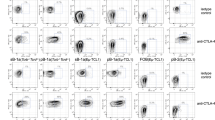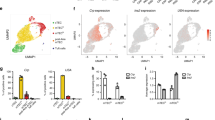Abstract
The thymus has two important roles in controlling the specificity of T lymphocytes. First, T cells differentiating in the thymus are rendered tolerant of ‘self’ antigens, particularly antigens encoded by the major histocompatibility complex, the H–2 complex in mice1. Second, the thymus imbues T cells with the property of H–2-restricted recognition of antigen, that is, the capacity of T cells to react with foreign antigens presented in association with self H–2 gene products2,3. Until recently it has generally been assumed that self-tolerance and H–2-restricted specificity both reflect early T-cell contact with self H–2 determinants expressed on thymic epithelial cells. Recent evidence suggests, however, that intrathymic cells of the macrophage/dendritic cell (MØ/DC) lineage also have a role in shaping T-cell specificity4–7. In particular, it has been found that the tolerance to graft-type H–2 determinants which normally ensues when T cells differentiate in an H–2-different thymus fails to occur when the thymus is pretreated with deoxyguanosine (dGuo)6,7,a procedure that selectively destroys MØ/DC but spares epithelial cells8. In contrast to these findings on tolerance induction, evidence is presented here that dGuo-treated thymus grafts do imprint T cells with H–2-restricted specificity for antigen. It appears, therefore, that induction of tolerance and H–2 restriction are controlled by different cells in the thymus.
This is a preview of subscription content, access via your institution
Access options
Subscribe to this journal
Receive 51 print issues and online access
$199.00 per year
only $3.90 per issue
Buy this article
- Purchase on Springer Link
- Instant access to full article PDF
Prices may be subject to local taxes which are calculated during checkout
Similar content being viewed by others
References
Klein, J. (ed.) Immunology: The Science of Self-Nonself Discrimination 1–687 (Wiley, New York, 1982).
Zinkernagel, R. M. Immun. Rev. 42, 224–270 (1978).
Bevan, M. J. & Fink, P. J. Immun. Rev. 42, 3–19 (1978).
Longo, D. L. & Schwartz, R. H. Nature 287, 44–46 (1980).
Longo, D. L. & Davis, M. L. J. Immun. 130, 2525–2527 (1983).
Ready, A. R., Jenkinson, E. J., Kingston, R. & Owen, J. J. T. Nature 310, 231–233 (1984).
von Boehmer, H. & Schubiger, K. Eur. J. Immun. 14, 1048–1052 (1983).
Jenkinson, E.J., Franchi, L., Kingston, R. & Owen, J.J.T. Eur. J. Immun. 12, 583–587 (1982).
Sprent, J. J. exp. Med. 147, 1838–1842 (1978).
Kappler, J. W. & Marrack, P. J. exp. Med. 148, 1510–1522 (1978).
Singer, A., Hathcock, K. S. & Hodes, R. J. J. exp. Med. 153, 1286–1301 (1981).
von Boehmer, H. & Haas, W. J. exp. Med. 150, 1134–1142 (1979).
Bevan, M. J. Nature 269, 417–418 (1977).
Zinkernagel, R. M. et al. J. exp. Med. 147, 882–896 (1978).
Matzinger, P. & Mirkwood, G. J. exp. Med. 148, 84–92 (1978).
Kruisbeek, A. M., Sharrow, S. O. & Singer, A. J. Immun. 130, 1027–1032 (1983).
Wagner, H. et al. J. exp. Med. 153, 1517–1532 (1981).
Corradin, G., Etlinger, H. M. & Chiller, J. M. J. Immun. 119, 1048–1053 (1977).
Robinson, J. H. J. Immun. 130, 1592–1595 (1983).
Barclay, A. N. & Mayrhofer, G. J. exp. Med. 153, 1666–1671 (1981).
Kyewski, B. A., Fatham, C. G. & Kaplan, H. S. Nature 308, 196–199 (1984).
Jordan, R.K., Bentley, A.L., Perry, G.A. & Crouse, D.A. J. Immun. 134, 2155–2160 (1985).
Zinkernagel, R. M. J. exp. Med. 156, 1842–1847 (1982).
Fink, P. J. & Bevan, M. J. in Recognition and Regulation in Cell Mediated Immunity (eds Watson, J. D. & Marbrook, J.) 107–125 (Dekker, New York, 1985).
Robinson, J. H. & Owen, J. J. T. Nature 271, 758–760 (1978).
Good, M.F., Pyke, K.W. & Nossal, G.J.V. Proc. natn. Acad. Sci. U.S.A. 80, 3045–3049 (1983).
Jenkinson, E.J., Jhittay, P., Kingston, R. & Owen, J.J.T. Transplantation 39, 331–333 (1985).
Jordan, R. K., Robinson, J. H., Hopkinson, N. A., House, K. C. & Bentley, A. L. Nature 314, 454–456 (1985).
Nathanson, S. D., Zamfirescu, P. L., Drew, S. I. & Wilbur, S. J. immun. Meth. 18, 225–234 (1977).
Author information
Authors and Affiliations
Rights and permissions
About this article
Cite this article
Lo, D., Sprent, J. Identity of cells that imprint H–2-restricted T-cell specificity in the thymus. Nature 319, 672–675 (1986). https://doi.org/10.1038/319672a0
Received:
Accepted:
Issue Date:
DOI: https://doi.org/10.1038/319672a0
This article is cited by
-
A guide to thymic selection of T cells
Nature Reviews Immunology (2024)
-
Modulation of TCR signalling components occurs prior to positive selection and lineage commitment in iNKT cells
Scientific Reports (2021)
-
Immunology (1955–1975): The Natural Selection Theory, the Two Signal Hypothesis and Positive Repertoire Selection
Journal of the History of Biology (2012)
-
Stem cell transplantation for immunodeficiency
Springer Seminars in Immunopathology (1998)
-
Thymic stromal cell specialization and the T-cell receptor repertoire
Immunologic Research (1997)
Comments
By submitting a comment you agree to abide by our Terms and Community Guidelines. If you find something abusive or that does not comply with our terms or guidelines please flag it as inappropriate.



